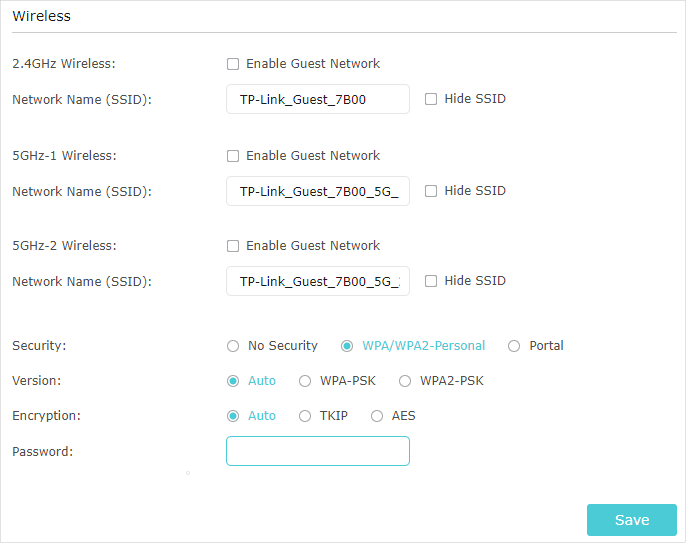Archer C4000 User Guide
- About This Guide
- Chapter 1 Get to Know About Your Router
- Chapter 2 Connect the Hardware
- Chapter 3 Log In to Your Router
- Chapter 4 Set Up Internet Connection
- Chapter 5 TP-Link Cloud Service
- Chapter 6 Guest Network
- Chapter 7 USB Settings
- Chapter 8 HomeCare – Parental Controls, QoS, Antivirus
- Chapter 9 Network Security
- Chapter 10 NAT Forwarding
- Chapter 11 VPN Server
- Chapter 12 Customize Your Network Settings
-
Chapter 13 Manage the Router
- Set Up System Time
- Control the LED
- Test the Network Connectivity
- Test Your Internet Speed
- Upgrade the Firmware
- Backup and Restore Configuration Settings
- Set the Router to Reboot Regularly
- Change the Login Password
- Default Password Recovery
- Local Management
- Remote Management
- System Log
- Monitor the Internet Traffic Statistics
- System Parameters
- Chapter 14 Work with Alexa and IFTTT
- FAQ
- Authentication
Chapter 6 Guest Network
This function allows you to provide Wi-Fi access for guests without disclosing your main network. When you have guests in your house, apartment, or workplace, you can create a guest network for them. In addition, you can customize guest network options to ensure network security and privacy.
It contains the following sections:
1. Create a Network for Guests
1.Visit http://tplinkwifi.net, and log in with your TP-Link ID or the password you set for the router.
2.Go to Advanced > Guest Network. Locate the Wireless section.
3.Create a guest network as needed.
1 )Tick the Enable Guest Network checkbox for the 2.4GHz/5GHz-1/5GH-2 wireless network.
2 )Customize the SSID. Don‘t select Hide SSID unless you want your guests to manually input the SSID for guest network access.
3 )Set Security to WPA/WPA2 Personal, keep the default Version and Encryption values, and customize your own password.

4.Click Save. Now your guests can access your guest network using the SSID and password you set!
Tips: To view guest network information, go to Advanced > Status and locate the Guest Network section.
Imagine that you run a small shop and provide a guest network for your customers. You want to seize every opportunity to promote your shop, which makes portal authentication an excellent choice. Customers will be directed to a web page for access verification, on which your personalized promotion is displayed. Moreover, you can specify a web link so that the newly connected guest will be redirected to, for example, the official website of your shop.
1.Visit http://tplinkwifi.net, and log in with your TP-Link ID or the password you set for the router.
2.Go to Advanced > Guest Network. Locate the Wireless section.
3.Select Portal for Security.

4.Select the Authentication Type.
•Simple Password – Specify a password for authentication (8-16 alphanumeric or “_” characters are allowed).
•No Authentication – Clients can access the network without any authentication.
5.Specify the Authentication Timeout. When a guest’s authentication expires, they have to reconnect to the network.
6.(Optional) Enable Redirect and enter the desired web link. The newly connected guest will be redirected to the website you have specified.
7.(Optional) You can click Click to Edit to personalize the authentication page.
•Portal Title – Up to 31 characters.
•Terms of Use – Up to 1023 characters.
•Logo Image – Upload a JPG or PNG image (less than 100KB) to customize the logo.
•Background Image – Upload a JPG or PNG image (less than 2MB) to customize the background.
8.Click Save.
3. Customize Guest Network Options
1.Visit http://tplinkwifi.net, and log in with your TP-Link ID or the password you set for the router.
2.Go to Advanced > Guest Network. Locate the Settings section.
3.Customize guest network options according to your needs.
•Allow Guests to Access Each Other
Tick this checkbox if you want to allow the wireless clients on your guest network to communicate with each other via methods such as network neighbors, Samba, Ping and FTP.
•Allow Guests to Access My Local Network
Tick this checkbox if you want to allow the wireless clients on your guest network to communicate with the devices connected to your router’s LAN ports or main network via methods such as network neighbors, Samba, Ping and FTP.
4.Click Save. Now you can ensure network security and privacy!
Tips: To view guest network information, go to Advanced > Status and locate the Guest Network section.